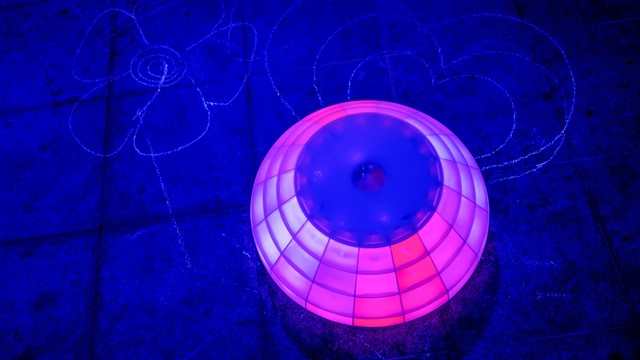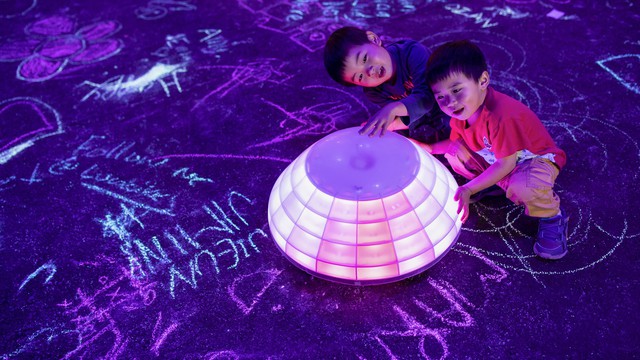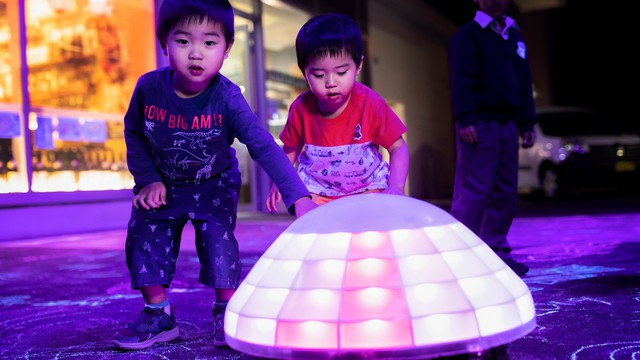Woodie 2019, Australia, Sydney
An Urban Robot For Hybrid Placemaking







Woodie is a slow-moving urban robot that draws on the ground using luminescent sidewalk chalk. The area in which the robot wanders around is illuminated with ultraviolet lights. By producing simple line drawings, Woodie turns the surrounding public space into a large horizontal canvas made of glowing words and drawings. Through its iconic, luminous shell, Woodie attracts passers-by to stop and contemplate, and invites them to draw with it and other people. The installation explores novel forms of pervasive urban displays and interrogates the role of urban robots in social spaces.
Cities around the globe are increasingly turning to testbeds for urban robotic experimentations, however, mainly to perform mundane tasks. What if we design robots with the aim in mind to create more engaging, creative and playful public spaces? Instead of striving for ever-increasing productivity and efficiency in cities, the installation Woodie explores the potential of robots to trigger urban reflection and slowing down. Woodie was a temporary installation designed by Marius Hoggenmueller, Luke Hespanhol and Martin Tomitsch for Vivid Sydney - festival of light, music and ideas. From the outset of our speculative design approach, the goal was to create a robotic device which could render digital content in a physical form, seamlessly integrated into the existing urban environment. Research has shown that conventional public displays in cities are often ignored by people due to the oversaturation of digital screens in our lives. The installation Woodie, instead, combines high-tech and futuristic city designs – in the manifestation of an urban robot – with a low-tech and traditional form of urban storytelling - chalk drawings on the street. Capable of translating digital illustrations into simple line drawings, Woodie uses the public space as a large horizontal canvas. The drawing area was illuminated by high-power ultraviolet lamps. As the intervention took place in winter evenings, the drawings were created with luminescent chalk sticks, for greater visibility at night and increased aesthetic perception of the space. Woodie itself, measuring around 60 centimeters in diameter, has a low-resolution lighting display integrated in its outer shell. Through the visualisations Woodie can communicate with passers-by. Thus, the robot can let people know about its creative process, the direction it intends to move, or cheekily complain if someone blocks its path. To allow people to add their own drawings on the ground, chalk sticks were made available around the installation site. Woodie successfully attracted people’s attention and acted as a facilitator for collaborative, creative placemaking. We observed evidence of emerging learning and creativity among children, manifested through watching, and then copying and adapting, some of the patterns drawn by the robot. Furthermore, Woodie provoked emotional responses and was perceived as a living being: people were touching, performing in front of Woodie or even talking to it. Overall, the installation Woodie incorporates established media architecture design elements, for example in the form of the robot's integrated low-resolution lighting display, while at the same time indicating a shift in the field towards the integration of new technologies, here in the form of mobile urban robots.
Details
Team members : Marius Hoggenmueller, Luke Hespanhol, Martin Tomitsch
Project leader(s) : Marius Hoggenmueller
Sponsors : Willoughby City Council
Descriptions
Credits
Marius Hoggenmueller
Marius Hoggenmueller
Marius Hoggenmueller
Marius Hoggenmueller
Destination NSW
Destination NSW
Destination NSW
Marius Hoggenmueller